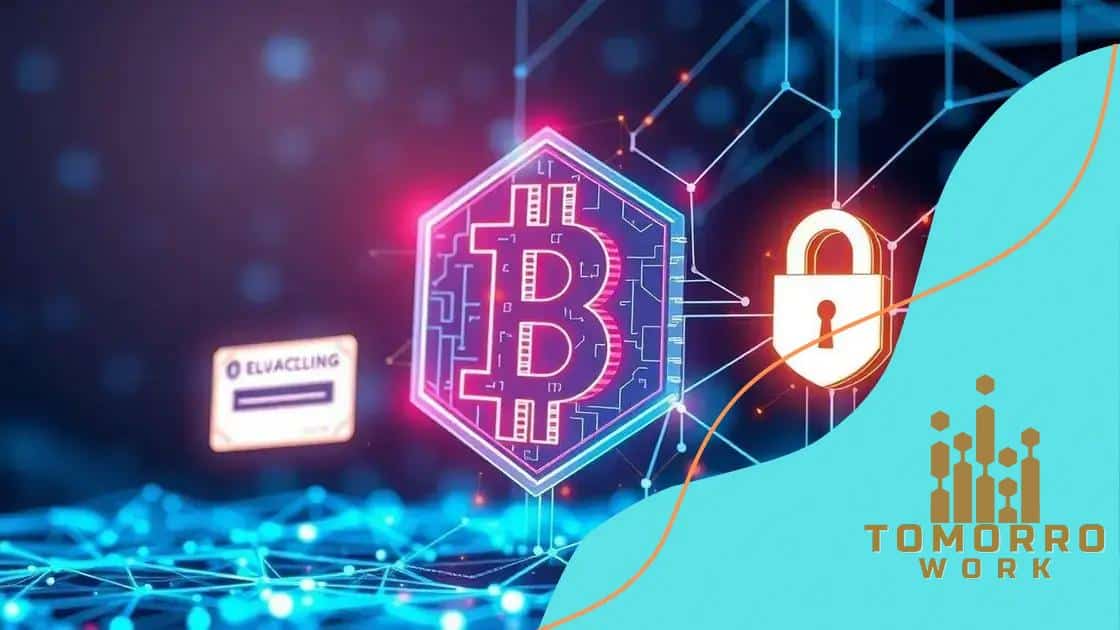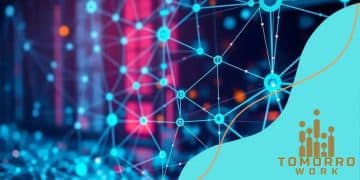How blockchain is securing educational credentials

Advertisements
Blockchain technology secures educational credentials by providing a tamper-proof, decentralized system that enhances trust, enables quick verification, and allows students control over their academic records.
How blockchain is securing educational credentials is changing the landscape of verification in education. Imagine a world where your degrees and certificates are instantly verifiable, reducing fraud and enhancing trust. Curious about how this technology can revolutionize your qualifications?
Advertisements
Understanding blockchain technology
Understanding blockchain technology is essential for grasping how it can revolutionize various fields. At its core, blockchain is a decentralized digital ledger that securely records transactions across many computers. This technology ensures transparency and security, making it a perfect fit for verifying educational credentials.
Key Features of Blockchain
One of the most significant advantages of blockchain is its immutability. Once a record is created, it cannot be altered without consensus from the network. This characteristic enhances trust and reduces fraud. Additionally, blockchain technology provides:
- Decentralization: There’s no single point of control, which prevents manipulation.
- Transparency: All participants can access the same version of the ledger.
- Security: Data is encrypted, making it difficult for unauthorized users to alter information.
The implications of this technology extend far beyond just financial transactions. For educational institutions, the benefits include the ability to verify student accomplishments without the need for intermediaries. This process not only saves time but also reduces costs related to credential verification.
Advertisements
Furthermore, when students earn their qualifications, these can be automatically updated on the blockchain. This feature not only enhances efficiency but also allows employers to trust the authenticity of the documents they receive. By using blockchain technology, schools can provide students with a secure digital badge that represents their achievements.
Applications in Education
Currently, several universities and organizations are exploring the use of blockchain for educational documentation. These pioneering efforts show promise in changing how educational credentials are stored and verified. Some key applications include:
- Diploma issuance: Diplomas can be issued and verified in real-time.
- Course credits: Students can track and share their course details seamlessly.
- Employer verification: Employers can verify candidates’ credentials more easily.
Ultimately, the shift towards utilizing blockchain technology in education can create a more secure and efficient verification process. As we continue to explore these innovations, the potential of blockchain in revolutionizing education credentials becomes increasingly evident. Awareness and understanding of how this technology functions will pave the way for broader acceptance and application in various fields, including education.
The importance of secure credentials
The importance of secure credentials cannot be overstated, especially in a world where fraud and misrepresentation are prevalent. As students complete their studies, ensuring that their educational credentials are safe and verifiable is crucial. Secure credentials provide both students and employers the assurance that qualifications are authentic.
Why Secure Credentials Matter
Having secure credentials enhances trust in the educational system. It allows employers to confidently assess potential candidates. Without robust systems in place, degrees can be easily falsified. This reality stresses the significance of verifying credentials efficiently and accurately.
- Trust: Employers gain confidence in hiring decisions when credentials are verifiable.
- Efficiency: Quick verification reduces time spent on background checks.
- Integrity: A secure system protects the reputation of educational institutions.
Furthermore, secure credentials ensure that information about academic achievements remains unchanged. Since blockchain technology stores credentials in a way that cannot be tampered with, it significantly reduces risks associated with fraud. Students can share their verified credentials with potential employers effortlessly.
This verification process is also crucial when exploring opportunities for further education. Institutions that require prompt and accurate confirmation of previous achievements benefit from secure credentials. As a result, both students and schools enjoy a reliable system that supports educational progression.
Impact on Students and Employers
For students, obtaining a secure credential means having a competitive edge in the job market. When they can provide unequivocal proof of their qualifications, they stand out to employers. On the other hand, employers benefit from a streamlined hiring process. They can quickly assess qualifications without prolonged back-and-forth communications.
- Enhanced employability: Students with secure credentials face fewer barriers in job applications.
- Reduced hiring risks: Employers can confidently hire candidates with verified degrees.
- Positive reputation: Trustworthy systems enhance the credibility of institutions.
In summary, recognizing the importance of secure credentials in education is vital for both students and employers. This understanding will lead to a more transparent, efficient, and trustworthy educational landscape.
Real-world applications in educational institutions

Real-world applications in educational institutions demonstrate how blockchain technology is transforming traditional methods of verifying academic achievements. Schools and universities are starting to adopt blockchain for various reasons, enhancing both security and efficiency in credential management.
Examples of Blockchain Use in Education
Several institutions have taken significant steps to implement blockchain solutions. These initiatives not only improve the verification process but also streamline operations. Some notable examples include:
- MIT Media Lab: This initiative was among the first to issue digital diplomas on the blockchain, allowing graduates to share their credentials securely.
- University of Nicosia: They introduced blockchain technology for issuing certificates, making them instantly verifiable online.
- Open College: They utilize a blockchain system to keep track of student achievements, simplifying the transfer process between universities.
These examples highlight a growing trend where institutions leverage blockchain to create more secure and efficient systems for credential verification.
As educational institutions continue to explore the potential of this technology, they find it capable of addressing common challenges. For instance, the traditional methods of issuing and verifying diplomas can often be slow and prone to human error. Blockchain resolves these issues, as it allows for real-time updates and remote verification of credentials.
Benefits for Educational Institutions
There are numerous benefits that educational institutions can derive from implementing blockchain technology. Some key advantages include:
- Cost-Effectiveness: Reduces the resources spent on verifying degrees and certificates.
- Enhanced Transparency: Provides a clear record of all transactions, fostering trust among students and employers.
- Increased Security: Protects sensitive data and prevents unauthorized changes.
Using blockchain for educational credentials also encourages innovative teaching methods. For example, institutions can offer micro-credentials or digital badges for short courses that students complete. This flexibility supports lifelong learning and enhances student engagement.
Not only does this technology benefit educational institutions, but it also profoundly impacts the students themselves. By utilizing a secure system, students can easily share their credentials while maintaining control over their information. This capability encourages transparency and simplifies the hiring process for employers.
Benefits for students and employers
Benefits for students and employers arise significantly from the implementation of blockchain technology in educational settings. This innovative approach not only streamlines the verification process but also enhances trust and security, which are crucial for both parties.
Advantages for Students
For students, the advantages of using blockchain are numerous. First, it provides them with a secure way to store and share their educational credentials. When students receive their diplomas or certificates, they can easily share verified copies with future employers. This capability reduces the time and effort needed for background checks.
- Control: Students can manage their credentials, deciding when and with whom to share their information.
- Accurate representation: Blockchain ensures that the credentials are tamper-proof, accurately reflecting their true academic achievements.
- Quick access: Students can access their credentials anytime, facilitating faster application processes.
Additionally, secure credentials empower students in their job search. They can confidently present their qualifications, knowing that employers will easily verify their authenticity. This advantage helps them stand out in a competitive job market.
Advantages for Employers
Employers also greatly benefit from the integration of blockchain in credential verification. By adopting this technology, they can streamline the hiring process, making it more efficient and reliable. For instance, employers receive verified information in real time, ensuring that they make informed hiring decisions.
- Reduced fraud: Employers can easily identify false claims, thus minimizing the risk of hiring unqualified candidates.
- Time-saving: The verification process becomes quicker and less costly, allowing HR departments to focus on core functions.
- Enhanced trust: Using a secure system boosts the company’s credibility and attracts top talent.
Employers who embrace blockchain technology gain competitive advantages, such as a more streamlined recruitment process and improved candidate quality. By relying on verified credentials, companies can attract better candidates who are genuinely qualified for the roles.
Potential challenges and future prospects
Potential challenges and future prospects in the application of blockchain technology for educational credentials are essential discussions as this innovative approach continues to evolve. While there are significant advantages, several obstacles must be addressed to fully realize its potential.
Challenges in Implementation
One major challenge is the integration of blockchain into existing educational systems. Many institutions operate on legacy systems, making it difficult to adopt new technologies. Training educators and administrative staff to use blockchain effectively is also necessary, which may require time and resources.
- Resistance to change: Some institutions may hesitate to adopt blockchain due to fear of the unknown.
- Costs of implementation: Developing and maintaining a blockchain system can be expensive.
- Data privacy concerns: Ensuring sensitive student information remains secure is critical.
Another significant concern is the standardization of blockchain protocols across different educational institutions. Without common standards, the interoperability of systems may face issues. This interoperability is vital for ensuring that credentials can be verified easily across borders and institutions.
Future Prospects of Blockchain in Education
Despite these challenges, the future prospects for blockchain in education are promising. As technology advances, more institutions are likely to recognize the value of secure digital credentials. With ongoing innovations, we may see the development of user-friendly platforms that simplify the implementation process.
- Global acceptance: More global institutions adopting the technology can lead to widespread acceptance.
- Enhanced collaboration: Collaborations between universities and tech companies can drive advances in secure credentialing.
- Increased awareness: Educating the public about blockchain’s benefits can help overcome resistance.
As the educational landscape continues to adapt to digital demands, blockchain presents a solution that addresses long-standing issues related to verification and security. By overcoming challenges related to integration and standardization, educational institutions can leverage the benefits that blockchain offers. The potential for innovation and improvement in the educational sector makes this an exciting area to watch in the coming years.
FAQ – Frequently Asked Questions about Blockchain in Education
How does blockchain enhance the security of educational credentials?
Blockchain technology ensures that credentials are tamper-proof, making it difficult for unauthorized users to alter or falsify educational records.
What are the main benefits of using blockchain for students?
Students benefit from better control over their credentials, quick access to their records, and the ability to share verified qualifications with potential employers.
What challenges do institutions face when implementing blockchain?
Institutions often encounter challenges like integration with legacy systems, training staff, and concerns over data privacy when adopting blockchain technology.
What does the future hold for blockchain in education?
The future looks promising as more educational institutions begin to adopt blockchain for secure credential verification, leading to increased trust and efficiency in the system.





